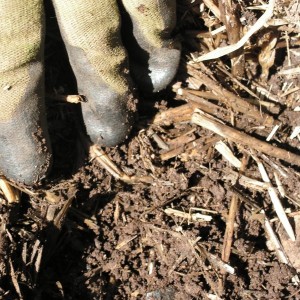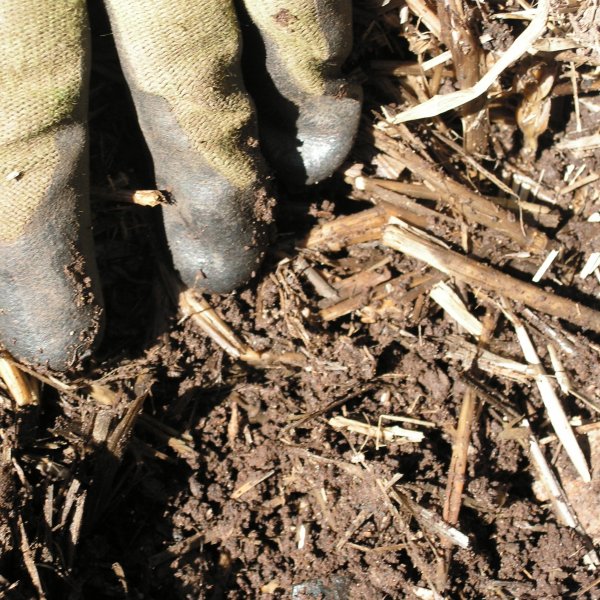 There is no vegetable garden in the world that cannot use and benefit from improvements to the soil. Soil improvements can be made in three ways:
There is no vegetable garden in the world that cannot use and benefit from improvements to the soil. Soil improvements can be made in three ways:
- Mulching: materials are added on top of the garden to retain moisture, and protect the underlying soil from erosion, sun, etc.
- Amendments: nutrient-dense organic matter is worked into the soil
- Cover Crops: grown in fallow seasons when the garden is not productive and incorporated into the soil prior to planting. Cover cropping can also be used as a living mulch in fallow seasons to prevent bare soil from being exposed to the elements.
Mulching
Mulching should be practiced at all times in a vegetable garden. Over time, mulches will break down and become part of the soil, therefore new mulch should be applied at the beginning of every growing season. Mulches can also be applied throughout the year, for example layering manure or fallen leaves in fall, or adding straw in spring. Mulches do not necessarily have to be high in nutritional value since it is their job to protect the soil from exposure, and they break down naturally to become organic matter and part of the vegetable garden.
In recent years it has been harder to locate un-sprayed straw for the garden in our area. Many conventional grain farmers have been using an application of glyphosate as desiccant in the final days before harvest, and we certainly don’t want that straw in our garden. This means we must find organic grain farmers willing to sell their straw, and we have had to look hard for them. One potential source is contract growers for straw-bale construction, which should also be pesticide and herbicide free straw.
There are other risks to using straw which have arisen recently due to the use of plant killing toxic pesticides by hay and grain farmers. I wish I could say this were not so, but if you make the mistake once it could cost you the entire garden. So be very careful where your straw comes from! Read the linked article to learn a test you can do before you put strw into your garden.
All garden soils improve with the addition of organic matter. Leaves from nearby trees added after they fall will break down into a very beneficial soil addition over the winter. Grass clippings (so long as they do not come from chemically treated lawns) can be added any time you mow the lawn and also work very well as a short-term nitrogen booster when mulched right around plants.
Tuck the grass clippings under an existing top dressing of mulch in an active garden and they will feed the plants with nitrogen right away. Do be careful not to incorporate rhizomous grasses as a mulch (quack grass, bermuda grass, etc.) as these are pernicious and will take over the garden. Compost these grasses rather than use them as mulch.
Another simple way to add a nitrogen top dressing mulch that also doubles as a slug repellent is to put a thin 1/2 to 1-inch layer of coffee grounds in the garden – over the garden perimeters and around vulnerable plants right to the stem.
Straw can be used as a top cover mulch starting anytime and will help retain moisture and protect soils from rains and wind. Do not mix straw into the garden soil, as it will change the carbon/nitrogen ratio of the soil and throw things out of balance; rather, let it break down on top as a mulch. It will work its way in once it has broken down and not disrupt the lifecycles of the organisms in the soil that way. Sawdust, wood chips and wood shavings can also be used in the garden as a mulch, but remember that wood will leach nitrogen out of the soil and so you will need to add other forms of nitrogen like those grass clippings if you are amending with any type of wood. Failing to do so will result in nitrogen starved vegetable plants which will not lead to a successful garden experience.
Add manures in the autumn, if you can, and don’t be afraid to add a nice thick layer and then cover in straw. Do make sure it is well rotted (aged) manure or you may be introducing weed seeds and other problems to the garden.
A good cover of manure and then a new straw mulch on top for the winter can even result in some plants which would normally not survive colder climates ‘wintering over’ perfectly well and sprouting up to be visible through the mulch or when it is pushed back in Spring to begin warming the garden soil in preparation for planting.
Improving Soil with Amendments
Amendments are added to the garden and worked into the top 8 to 10 inches of soil, or dug in beneath the site where a transplant will be placed up to two weeks prior to planting.
Compost is superb in the garden because it contains the micro-organisms that keep gardens healthy – and if it has worms in it, so much the better. Vermiculture (raising worms which then eat your table scraps and other vegetable waste) can be used to produce worm castings which have been called a gardener’s black gold because they are essentially a perfect time-released organic soil amendment that adds body, aeration, and nutrition all in one move.
Well-composted manures can also be used as amendments directly in the garden soil. When mixing in manures it is important to consider the condition of the manure. Fresh manure will burn plants and may also carry weed seeds or other problem ingredients. Composted manure or manure which has been allowed to age for at least a year is far more reliable and less troublesome, and can be worked into the top 8 to 10 inches of the soil a few weeks before planting or laid over in a generous cover at the end of the growing season and then re-topped with mulch. If the garden is heavily mulched, pull the mulch back and apply up to 2 pounds per square foot of manure, then place the mulch back on top of the manure. Manures can be added mid-season for long season and heavy feeders at a rate of about 1/2 pound per square foot of garden.
Do not apply manures directly to plants unless the manure has been composted first. Well composted manures have no smell, and have the texture and appearance of rich dark soil.
Ground bone meal, blood meal, fish products and seaweeds can be worked into the soil just prior to planting. Follow instructions from supplier for application. Generally, these amendments do not burn plants and can be worked into the soil throughout the garden or as the garden is planted.
The following amendments are all excellent nutrients to add to the garden; particularly when first getting started with a new plot:
- Fish meal
- Bone meal
- Blood meal
- Glacial and volcanic rock dust granules or powders
- Azomite (volcanic rock dust)
The rock dusts are excellent sources of trace minerals and provide a broad spectrum of inorganic (not organically bound) minerals which greatly enhance microbial life in garden soils.
If soil is particularly dry and lacking in the ability to hold moisture, an amendment such as coir (ground up coconut husk) can be added to aid in soil moisture retention.
Generally, fine ground amendments such as bone or blood meal, rock dust or seaweeds can be worked in a little bit at a time with the planting of seeds or transplanting of seedlings into the garden. Many gardeners like to mix in a handful of bone or blood meal beneath the surface when transplanting heavy feeders like tomatoes, peppers or eggplant. You can also top dress with these nutrients during the growing season, taking a few teaspoons and working them into the top inch or two of soil around the plants.
Cover Cropping for Improved Garden Soil
Finally, in an interesting and exciting return to much older farming methods, new research now documents significant advantageous results of cover cropping. A cover crop is planted in the garden bed after the last harvest, and sometimes again in early spring, and cut down and incorporated into the garden bed before it reaches maturity.
Legume Cover Crops For Nitrogen Fixing
To improve nitrogen in a garden, legumes are used as the cover crop, such as clover, hairy vetch, field peas or alfalfa.
Erosion Control, Preventing Nutrient Leaching Over Winter
In gardens where nitrogen is plentiful and manures are added in fall, grain cover crops such as oats, winter rye, wheat or barley can keep the nutrients from leaching out over winter and prevent erosion and ‘sealing’, a process where the soil stops absorbing water when no organic matter is growing.
Cover crops help maintain the health of earthworms and other organisms beneficial to the garden, like lady beetles and ground beetles.
Research has shown that it is best to cut the cover crop down when it is slightly less than half grown as this will provide the highest nitrogen to the garden bed. You do not have to till the cover crop under – you can just move it down and lay the cut crop on top. Legumes as a cover crop will increase nitrogen fixing in the soil as their roots fix nitrogen from the air directly. This can also be done in early spring before planting.
Cover crops help condition the soil with their roots which when left behind by the cutting will rot into the soil providing great food for worms, and all the soil creatures who will consume them. The tops, once cut provide more organic matter and soluble nitrogen directly to the soil. Increases in yields are typical and common after cover-cropping a garden, and it is substantial enough many farmers are now routinely cover-cropping.
Resources:
Glacial Rock Dust and Best Types of Rock Dust to Use in Gardening: http://remineralize.org/a-rock-dust-primer
Azomite F.A.Q.: http://www.azomite.com/index.php?option=com_content&view=article&id=60&Itemid=41
Manure Safety in the Garden: http://gardening.wsu.edu/stewardship/compost/manure/manure2.htm
Soil Amendments:


